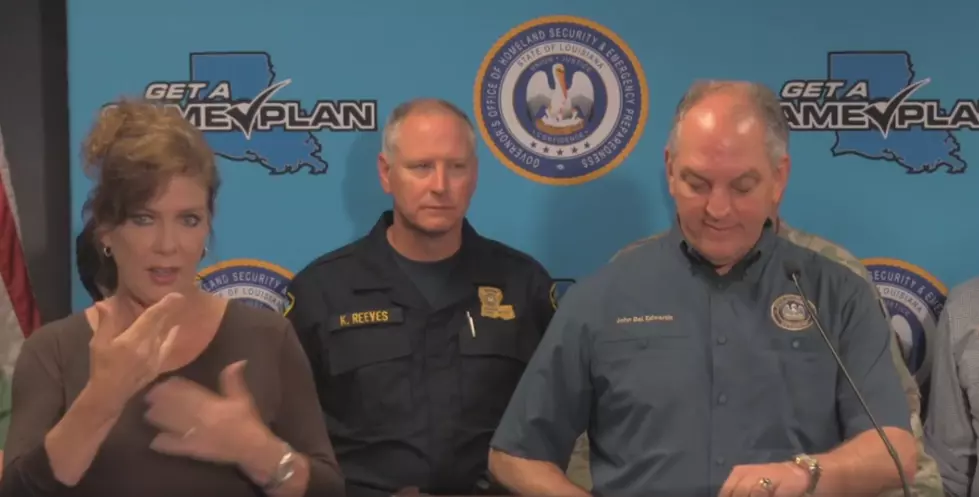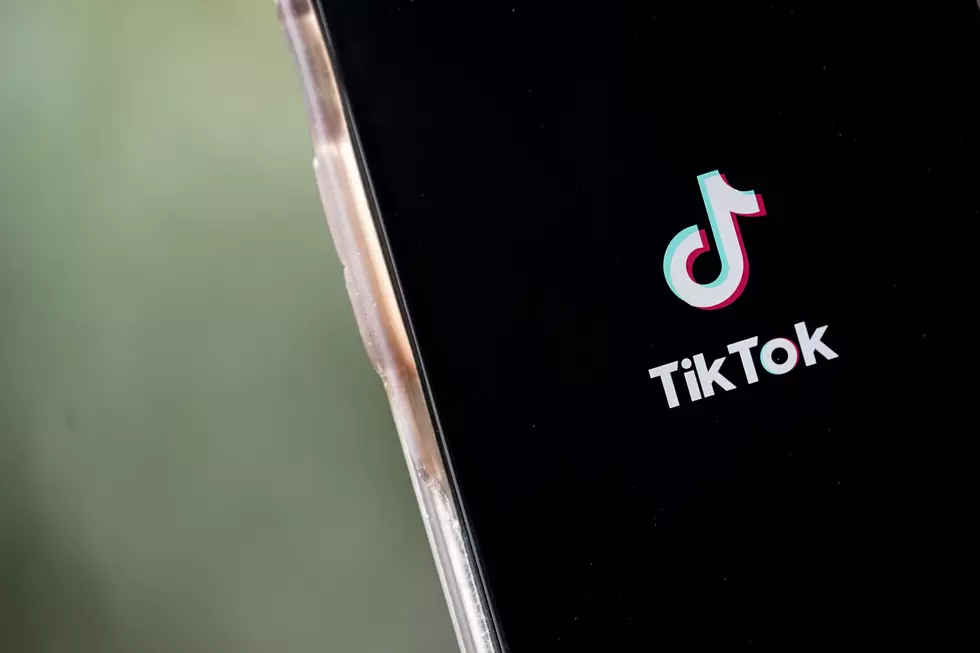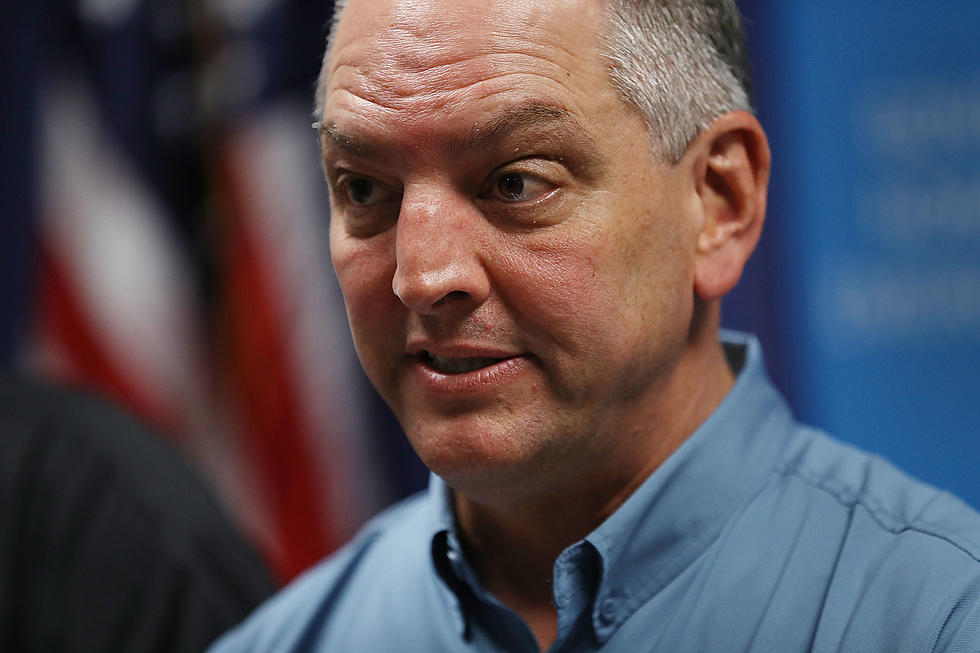
Governor Edwards ‘Grateful’ Storm Wasn’t Worse
NEW ORLEANS (AP) — The Latest on Barry (all times local):
6:20 p.m.
Louisiana's governor says he is "extremely grateful" that Tropical Depression Barry did not cause the disastrous floods that had earlier been forecast.
In a news conference Sunday evening, Gov. John Bel Edwards said Barry's rains could have been much worse. He says the state is now better prepared for future storms.
Edwards says more than 90 people have been rescued from 11 parishes because of the storm. He does not believe there have been any weather-related fatalities.
The governor urged residents to be cautious when going outside and to avoid any downed power lines.
The state is ramping down its emergency response activities as most of Louisiana appears to have dodged a bullet from once Hurricane Barry. There were concerns that the levees in New Orleans would have difficulty handling the storm, but Governor John Bel Edwards says the upgraded levee system held up.
“The risk reduction system was completely button up and closed off, and from here, it appears to have performed extremely well.”
There were concerns of overtopping due to the Mississippi River being at around 16 feet due to historic rainfall in the Midwest.
Edwards thanked the emergency personnel who rose to the occasion during the storm. He says operations took place in a number of locations.
“Altogether with search and rescue across Louisiana, 93 individuals were saved from 11 parishes.”
48 of those came from one facility that was evacuated early Sunday morning in Iberia Parish.
___
5:05 p.m.
Federal officials say the response to Tropical Depression Barry has gone well, although they remain concerned about the risks of flooding and heavy rainfall.
Acting Homeland Security Secretary Kevin McAleenan says he was briefed on the storm and response efforts Sunday afternoon.
Neil Jacobs of the National Oceanic and Atmospheric Administration says significant rainfall is expected to fall as the storm continues moving inland.
McAleenan says officials are keeping a close watch over Barry, but are optimistic. He praised Louisiana Gov. John Bel Edwards and local officials for their response to the storm.
Officials say there have been 13 rescues and nearly 90,000 customers in Louisiana remain without power. Of the 23 shelters still open, fewer than 300 people remained.
___
3:45 p.m.
Tropical Storm Barry has now weakened to a tropical depression, but forecasters warn flooding rains and tornadoes are still possible as the storm winds down.
The National Hurricane Center in Miami downgraded the storm in a Sunday afternoon advisory and removed all tropical storm warnings.
Forecasters say Barry's maximum winds are down to 35 mph (55 kph). Its center was about 20 miles (35 kilometers) north-northeast of Shreveport in northwest Louisiana.
The National Weather Service says flooding rains and tornadoes are happening well east and south of the storm's center and should continue into Monday as what remains of Barry moves north into western Arkansas.
___
Noon
As Tropical Storm Barry slowly winds down and moves away, storms well away from the center have prompted a rash of tornado warnings.
The warnings have been in the outer bands of the storms just east of Baton Rouge and in Mississippi.
Some trees have been knocked down and minor damage reported to buildings in East Baton Rouge and Denham Springs, but no serious damage or injuries have been reported.
Forecasters say the chance for tornadoes In Mississippi and east of the Mississippi River in Louisiana will continue throughout Sunday.
___
11:15 a.m.
Louisiana authorities say that a family they tried to rescue from high water was doing OK and preferred to stay in their home.
KTBS-TV reported that rescuers tried Saturday night to reach the family near Franklin, which is about 40 miles (64 kilometers) southeast of Lafayette.
The Bossier Parish Sheriff's Office was eventually able to reach the family, but they preferred to stay in their home.
Deputy Steve Dooley said that authorities drove through water that was almost impassible but made it eventually to the house where the family was.
He said: "We made it to the house, and they just didn't want to come out."
Deputies told the station that they weren't aware of any injuries from the storm in the parish.
___
11 a.m.
Tropical Storm Barry's winds weakened slightly to 40 mph (65 kph), but the risks associated with the storm - including flooding and tornadoes - are sparking new concerns.
The National Hurricane Center in Miami said in its 11 a.m. Sunday advisory that the storm's center was located about 50 miles (85 kilometers) south-southeast of Shreveport, Louisiana, and was moving north at 9 mph (15 kph).
The center discontinued a storm surge warning it had issued from Intracoastal City to the mouth of the Atchafalaya River.
The National Weather Service issued a tornado warning for parts of Louisiana including East Baton Rouge until 10:30 a.m. CDT. A flash flood warning was in effect for Iberia, Lafayette, St. Martin, and Vermilion parishes until 1:15 p.m. CDT.
__
8:45 a.m.
Flights are arriving and departing again from the New Orleans airport as Tropical Storm Barry heads north.
The Louis Armstrong New Orleans International Airport said in a statement Sunday morning that most airlines are returning to normal operations. The airport is advising passengers to arrive at least two hours early as they could encounter long lines.
Delta Air Lines spokesman Drake Castañeda said Sunday that the Atlanta-based company resumed normal operations in New Orleans Saturday night. Castañeda said Delta flights from Atlanta and New York landed in New Orleans shortly before 7 p.m. Saturday.
___
7:35 a.m.
President Donald Trump is urging Gulf Coast residents to be careful as Barry continues dropping rain across the region.
In a Sunday morning tweet, Trump said: "A big risk of major flooding in large parts of Louisiana and all across the Gulf Coast. Please be very careful!"
The storm's center is moving over Louisiana on Sunday morning and is expected to move over Arkansas overnight and into Monday.
In its latest update, the National Hurricane Center said the storm is expected to become a tropical depression as it loses energy while moving over land Sunday. Barry's maximum sustained winds were at 45 mph (72 kph) as of 7 a.m. CDT Sunday. But forecasters say the flood threat will continue, partly because of the slow movement of the storm.
___
7:25 a.m.
Barry is forecast to weaken to a tropical depression soon, but is still expected to drop torrential amounts of rain across a wide region of the South as its center moves over Louisiana on Sunday and Arkansas on Monday.
In its latest update, the National Hurricane Center said the storm is expected to become a tropical depression as it loses energy while moving over land Sunday. Barry's maximum sustained winds remained at 45 mph (72 kph) as of 7 a.m. CDT Sunday.
But forecasters say the flood threat will continue, partly because of the slow movement of the storm. It was moving across Louisiana Sunday morning at about 6 mph (10 kph).
___
5:45 a.m.
A severe thunderstorm embedded in one of Barry's outer bands began rotating over Mississippi before dawn Sunday, prompting a tornado warning.
There were no immediate reports of any injuries or damage.
The National Weather Service in Jackson says the storm early Sunday morning was capable of producing a tornado near the small town of Ellisville, Mississippi.
Ellisville is about 85 miles (137 kilometers) southeast of Jackson.
___
4:45 a.m.
Forecasters say the storm that's drenching Louisiana has now prompted a flash flood warning that covers Mississippi's capital city.
The National Weather Service said early Sunday that up to 3 inches (7.6 centimeters) of rain had already fallen in the Jackson area — and more was on the way.
Before dawn Sunday, a narrow band of heavy rain was still streaming north through Jackson. The weather service said that could bring an additional 2 inches (5 centimeters) of rain to the area.
The U.S. National Hurricane Center's 4 a.m. advisory says Barry was centered around 80 miles (125 kilometers) southeast of Shreveport, Louisiana.
___
2:10 a.m.
The latest advisory from the U.S. National Hurricane Center has discontinued a tropical storm warning for the area including metropolitan New Orleans, although the warning is still in effect from Morgan City to Cameron.
The storm surge warning from the mouth of the Atchafalaya River to Biloxi, Mississippi, was also discontinued as of the 1 a.m. Sunday advisory, but the warning is still in effect for Lake Pontchartrain and the area between Intracoastal City and Biloxi.
The agency says Barry is still carrying "life-threatening flooding rains" as it moves over Louisiana. Forecasters say Barry will move across central and northern Louisiana and then over Arkansas on Sunday night and Monday.
Maximum sustained winds had decreased to near 45 mph (75 kph) and the storm was centered around 45 miles (75 kilometers) southwest of Alexandria.
___
12 a.m.
A weakened Barry inundated the Gulf Coast but appears unlikely to deluge New Orleans as it slowly advances.
Still, Gov. John Bel Edwards on Saturday night urged residents across south Louisiana to stay "vigilant." He warned that Barry could still cause disastrous flooding across a wide stretch of the Gulf Coast overnight.
On Saturday, New Orleans had been braced for heavy rains, but instead had intermittent bands of moderate showers and occasional sunshine.
Forecasters downgraded rainfall estimates for New Orleans through Sunday to between 2 to 4 inches (5 to 10 centimeters). Experts had earlier said the city could get up to 20 inches (50 centimeters) of rain.
As of late Saturday night, the storm had maximum sustained winds of 50 mph (80 kph) and was centered 35 miles (56 kilometers) southwest of Alexandria.
More From 97.3 The Dawg










